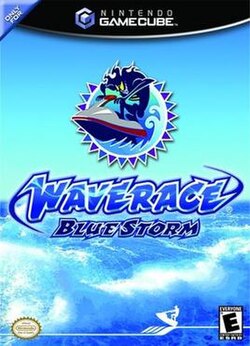Championship mode
Players begin by selecting a character to use for the entire championship. Following this, the player is shown the courses on which they can race and a weather forecast for each day of the circuit. The more difficult the circuit, the more races (and thus days) the player must complete. Players can select the order in which they wish to race the courses. This decision can be affected by aforementioned forecast. If players find a certain course to be more difficult when it is raining, they can elect to play that course on a day which is forecast to be sunny.
After the selection of a course, gameplay begins. Players begin in a field of eight racers. Position at the beginning of a race is determined by your finish in the previous race, e.g. a player finishing third in one race will begin in the third position before the starting line of the following race. In the first race, players begin in eighth. As the player waits for the race to begin, a stoplight changes from red to yellow to green, indicating the start of the race. For pressing the accelerator exactly as the light turns green, the player will receive a turbo, which can be activated at the player's whim and which significantly boosts the speed of the player's craft for a short time.
The player then begins to navigate the course. In every course, buoys are set up in two colors: red and yellow. Red buoys are supposed to be passed on the right; yellow buoys on the left. Passing buoys correctly builds up the player's turbo meter. Other than the method mentioned above, which only works at the very beginning of a race, turbos can only be acquired by correctly navigating five of these buoys or by performing a stunt. Each stunt, unlike each buoy, fills from one-fifth to three-fifths of the meter depending on the stunt. Incorrectly passing a buoy results in the loss of any built-up turbo stages. This leads to some degree of strategy. For example, a player might build up a turbo, then use it to cut off a buoy placed in an awkward manner, or one off a distance to the side, thus eliminating much of the time that would have been used to get to and correctly pass that buoy.
There are other, smaller red buoys which mark the boundaries of each course. Staying outside of them for too long results in a disqualification.
During the race, the player is often bombarded (depending on weather conditions) with waves and rain which can force an inexperienced player off-course, or into obstacles or other riders. Successful navigation of these waves is essential. This is where the game's uniqueness in the genre comes to light. Waves are completely random and are affected by the weather, making for a different experience from that of most other games in the racing genre, such as the PlayStation 2's Splashdown . Every race consists of three laps. Often during a race, shortcuts will be revealed as the player passes each lap. Spotting these shortcuts as they appear can be essential to victory.
At the end of each race, the player is awarded points proportional to the place in which they finished. A player needs a certain point total at the end of each race in order to advance to the next day. If this total is not reached, the player must begin the circuit again.
Victory comes when the player finishes first, second, or third overall in total points at the end of the circuit. For the expert circuit, the player must finish first for all weather conditions in time attack mode.
